The Perfect Luxury Escape to Seychelles: Everything You Need to Know Plus Where to Go and What to See
Long before Kate and Will honeymooned in the Seychelles, I dreamed of visiting the Seychelles islands. This paradise on Earth is located in Indian Ocean, northeast of Madagascar, and east of Tanzania and Kenya, i.e., far, far away. I checked in with my luxury expert, Beth who is just back from a fabulous vacation here. So let’s find out more about The Seychelles
A LITTLE SEYCHELLOIS HISTORY AND ISLAND FACTS
The 115 granite and coral Seychelles islands-41 Inner Islands and 74 Outer Islands-were first settled in 1770 by the French. Most are uninhabited, i.e., no lodging or complicated to get to unless you plan far in advance and pony up some major bucks (I tried).
THE INNER ISLAND GROUP
The 43 Inner Islands cluster mainly around the principal islands of Mahé, Praslin, and La Digue. Here is a La Digue sunset!
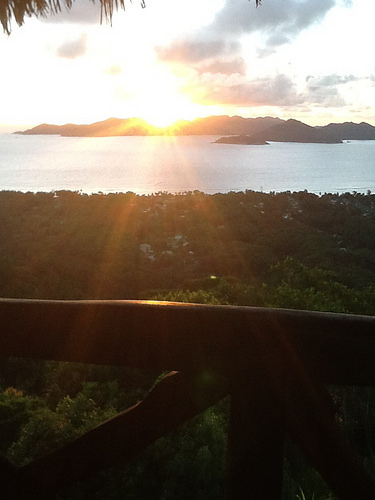
Mahé (pronounced Mah-hey) is the largest island of both island groups and is home to the main airport, Seychelles International Airport (SEZ), and the nation’s capital, Victoria, which is the smallest capital city in the world. 71,000 people reside on this 96.1 sq. mile island. Praslin (pronounced Prah-lee) is the second-largest Inner Island at 23.3 sq. miles and home to 7,100 residents. This island is an hour and fifteen minute high-speed ferry ride from Mahé. One of the Seychelles’ two UNESCO World Heritage Sites is here: Vallée de Mai, where the Coco-de-mer nut grows, aka “the butt nut”. [Butt nut photo here] La Digue(pronounced La Deeg) is the smallest Inner Island. 2,100 people reside on this 6.2 square mile island. If you live here, everyone truly knows your name. This island is 31.1 miles from Mahé and from Praslin takes an additional 15-20 minutes to reach via ferry. Biking is the main mode of transportation on this little island. Even slower are the ox-drawn carts on La Digue-those poor ox looked pretty bummed to be in the 90 degree heat carting around a cart full of people too lazy to even walk.
THE OUTER ISLAND GROUP
The 72 Outer Islands are beyond the Seychelles plateau and are less frequently visited due to their relative remoteness and substantial logistical difficulties in planning a visit (e.g., to visit the UNESCO Heritage Site, Aldabra, which is 700 miles from Mahé, you have to charter your own flight, boating, lodging and pay an impact fee). If you can afford the time and money needed to visit these islands, you’ll find virtually untouched habitats with countless species of wildlife, as well as unparalleled opportunities for sailing, fishing and diving in places where few have gone before. Oh, and P.S. “Due to the activities of pirates operating from Somalia, [there are] strict restrictions on the movements of commercial hire craft operating in the outer islands.”
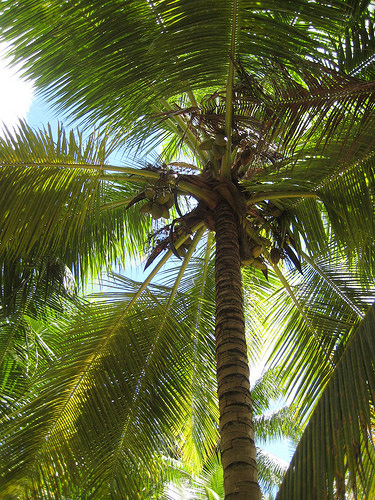
GETTING TO THE SEYCHELLES
It will take no less than 17 hours flight time and two flights from the U.S. east coast to reach this tropical paradise. There are flights though from Dubai, Abu Dhabi, Hong Kong, Nairobi, Mauritius and Johannesburg. Once you endure sitting for about 17 hours, you’ll arrive at Seychelles International Airport (SEZ), located 6.8 miles south of the national capital, Victoria. I highly recommend booking a flight with an extended layover at your connecting airport’s city. It is often the same price as a ticket with only a four-hour layover. Why not get out and explore the world instead of shopping duty free in an airport?
Note: U.S. Citizens do NOT need a Tourist Visa to enter the Seychelles. Also be prepared at Customs to show proof of lodging since camping on beaches is prohibited.
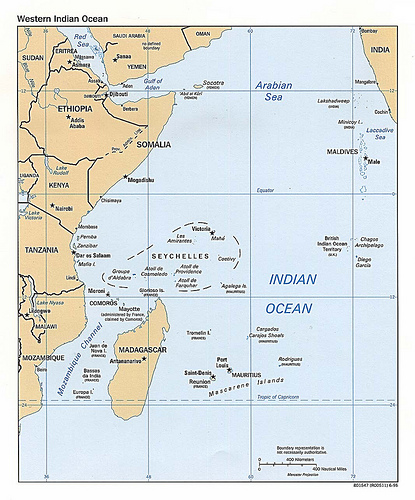
GETTING AROUND THE SEYCHELLES
TAXIS
There is a taxi line at the airport. Taxis are the driver’s privately-owned vehicle—there are no uniform, yellow cabs. Negotiate the price to take you to your destination. I did not do this and was ripped off big time. (Read the currency section below.) Drivers usually accept Rupees, Dollars, or Euros-just ask. Your hotel may arrange transport from the airport if you want to skip the taxi line.
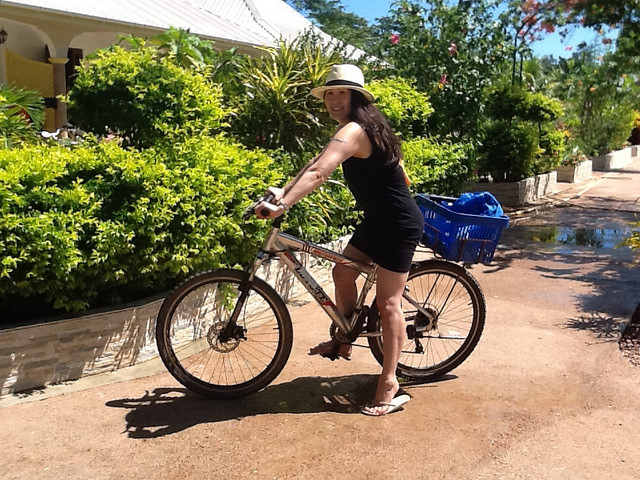
WALKING / BIKING
Biking is practical only on La Digue. I suggest renting a bicycle for $10 a day—La Digue is small, but it’s still six square miles, which is a lot of walking. The bikes have baskets to carry your beach goods. My NYC paranoia kicked in, and I asked for a bike lock. I was laughed at-apparently no one steals bikes. Just be sure to pedal your bike around before you ride off with it to make sure it’s in good working order. Mahé and Praslin are too large and hilly to traverse by foot or bike.
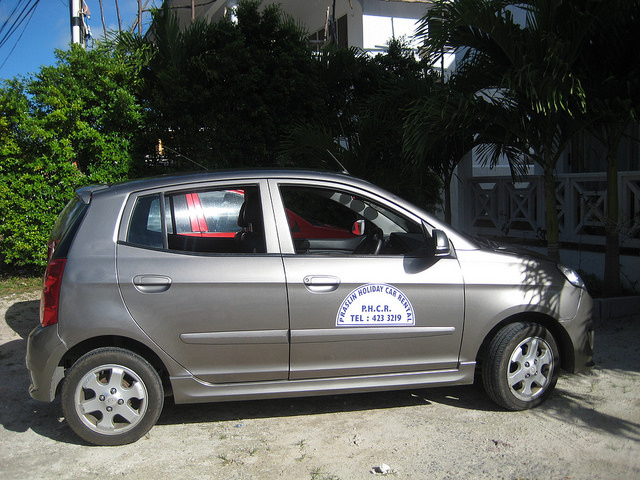
RENTING A CAR
This is very easy—you show your license, sign at the “X” and drive away. The rental agent didn’t seem to care that I had only ever driven in the right side of the road. One of the cars I rented didn’t even have a full tank of gas-I was told to return it “about 1/4 full”.
Driving is on the left side of the road, the steering wheel is on the right side of the car, and everything is opposite of what you’re used to (rear-view mirror is to your left, turn signal is on the right). If you can buy additional car insurance, DO IT. I did not, and paid an extra €400 for a fender bender that was not even my fault.
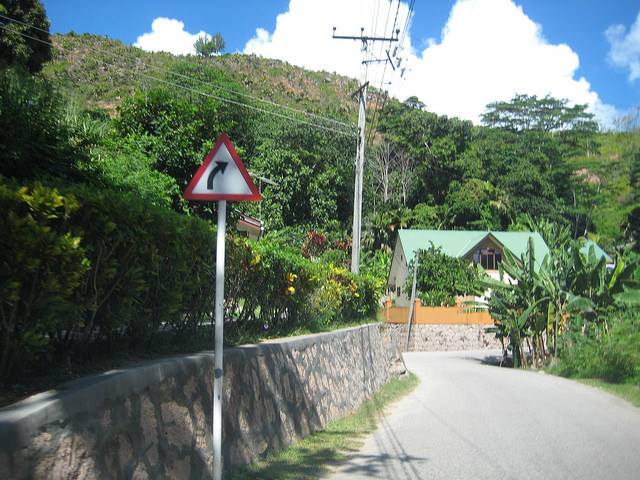
Also, the roads are full of hairpin turns and some pretty steep hills. I was amazed my little clown car actually made it up the hills. There are not a lot of places to pull over (the roads are like one huge driveway), so keep that in mind and know this is why cars are sometimes just parked in the middle of the lane. Praslin and Mahé each have one main road that follows the permitter of the island, so it’s virtually impossible to get lost. Except when the road signs are completely overgrown with trees.
PUBLIC TRANSPORTATION
If you are brave and have loads of time to spare, take the bus. But you cannot carry on anything larger than a backpack, so unless you are one super-light traveler, this won’t be an option from the airport. A hotel staffer told me it takes 1.5 hours to get to work on the bus. This is one slow mode of transportation.
FERRY
Cat Cocos is the main interisland ferry company, and they run ferry service to and from each island daily. (Ferry Schedule Here). Tourists pay 350% more than residents; a resident’s one-way ticket from Mahé to La Digue is about $20, and this same ticket will cost you about $90 (please, feel free to check my math). The ferry is air-conditioned inside with an outdoor deck if 1. Your ticket permits you to go upstairs at the Mahé ferry or 2. You get in line and up the stairs first at the La Digue ferry. There are snacks and beverages for sale inside and free Wi-Fi, though I never figured out how to access this.
The boarding process is an unorganized free-for-all. I stood in line forever before I realized I was in the line for passengers disembarking the ferry to collect their luggage. Or it actually was also one of the boarding doors if you shoved your way to the actual door. And there was a second door that attendants were standing at and just staring at everyone in the wrong line.
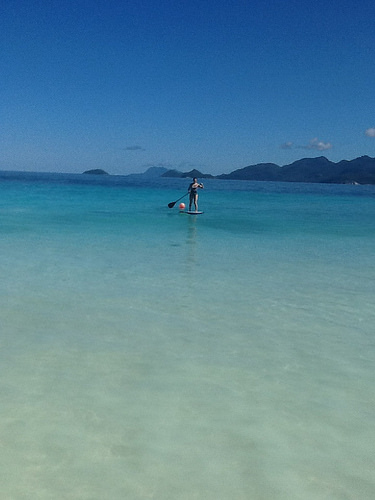
WHAT TO DO IN THE SEYCHELLES
If you are looking for non-stop action or a wild and crazy night life, do not visit here-there are only four nightclubs and three casinos on all three islands. This destination is for the beach-lover and ocean and marine-life enthusiast looking to truly relax, unplug, and escape real life.
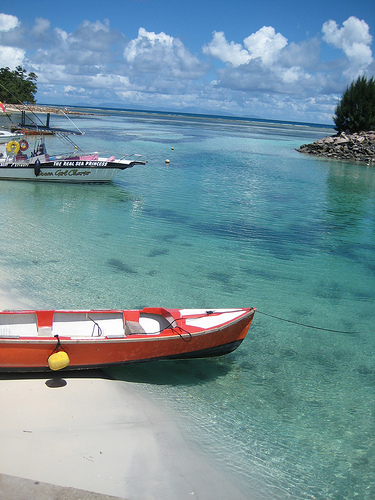
WATER ACTIVITIES / SPORTS
You can snorkel, dive, swim, surf, canoe, Jet Ski, paddle boat, wind surf, Stand-Up Paddle, charter private boats or fishing excursions…the options are virtually endless. Either your hotel will have the equipment on site to do these activities, or you can charter any of the many tour or rental companies. I packed my own snorkel equipment since I’m a slight germaphobe. And if you want to golf, Mahé and Praslin each have a 19-hole golf course, or you can rock climb if you’re feeling adventurous. At the very least, snorkel. You will see some beautiful fish in some amazingly crystal clear water.
NATURE
Mahé has one national park, Port Launay Marine National Park, which is famous for its whale shark sightings. You can experience an original, 18th Century French tradition of the spice trade by visiting Le Jardin Du Roi Spice Garden . Or you can take a steep, uphill hike on Morne Blanc and be rewarded with sweeping views of the western seaboard. Seychelles National Botanical Gardens is one of Seychelles’ oldest National Monuments, dating back more than a century. It houses a wide collection of mature, exotic and endemic plants, as well as Aldabra tortises, fruit bat colonies and orchid house within five acres of landscaped and beautifully maintained tropical gardens.
To get to the world’s best beach (Anse Source d’Argent on La Digue), you enter L’Union Estate and pay an entrance fee. I whizzed past the little sign stating there is an entrance fee. A large woman on a porch yells, “Come back!”. Then you stand around and wonder why she yelled at you and why you are actually standing there with everyone else who also stopped their bicycles. Anyway, this Estate has a vanilla plantation and an old mill, but all I noticed (Seychelles really has a lack of good signage) was an area packed with tortoises that would make PETA die a thousand deaths. Just make it past this and you will be rewarded with the world’s best beach.
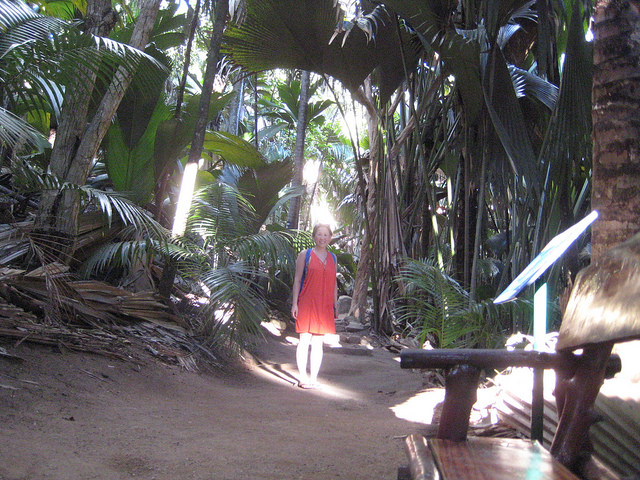
Praslin’s UNESCO World Heritage Site, Vallée de Mai, is a nature sanctuary that looks like a lost world. I felt like Thumbelina in Jurassic Park, and at any minute I could float away on my leaf boat or be eaten by a T-Rex. I found you need about half the time suggested to walk each of the three paths.
On Praslin, there is a “great viewing point”, Zimbabwe (not far from Anse Lazio), but as noted above, the roads are like one large driveway. There was no turnout to pull over and look at the view, so you just drive really slowly or just stop in the middle of the road and hope no one tears around the corner and runs into you.
SHOPPING / CITY LIFE
This will be found only on Mahé in the capital city of Victoria, the world’s smallest capital. Art studios dot all the islands, and you will find little markets that sell tourist souvenirs and the like. The little side-of-the road markets are slightly questionable (let’s just say I would not buy anything perishable there). Just do not plan on any serious shopping here—do this when you’re in Dubai at the Dubai Mall during your layover.
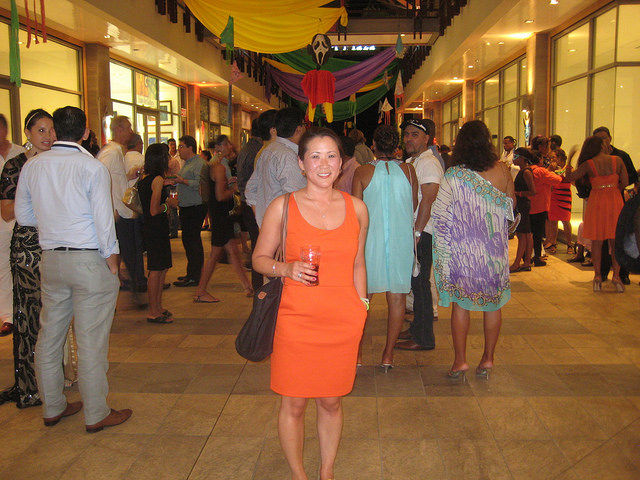
THE BEACHES
Most importantly, the beaches. Some of the world’s most pristine beaches can be found here. The ocean was pretty shallow for quite a ways out—no sudden drop offs at any beach, and at some beaches, the water was too shallow for swimming. I swear even the seaweed was different here. Not slimy or prickly, just soft and fluffy, and I did not mind walking barefoot on it. And this says a lot because I usually cannot stand even walking around a swimming pool without shoes.
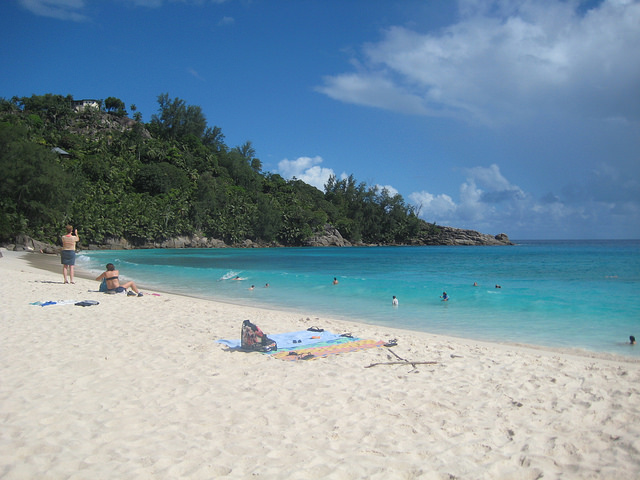 Anse Intendense
Anse IntendenseYou really cannot go wrong with any beach, though some will have more sand and some will have more rocks. If you can make it to just a few beaches on Mahé, go to Anse Intendense and Anse Takamaka (next to each other on the southwest coast), Petite Anse (Four Seasons Resort Seychelles is here), and Port Launay and Paie Ternay National Marine Parks. I wanted to go to Beau Vallon but got lost.
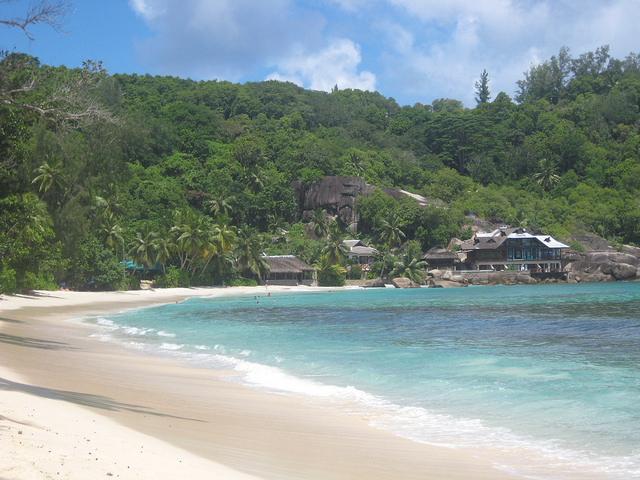 Anse Takamaka
Anse TakamakaThe top beaches on Praslin: I stayed at Anse Volbert (also called Cote d’Or) but spent the day at the spectacular Anse Lazio, voted one of the best beaches on Earth. And there are two near-by restaurants (one beach side) where you can get bottled water and snacks. I did wade out into Anse Consolation because I thought the name was great.
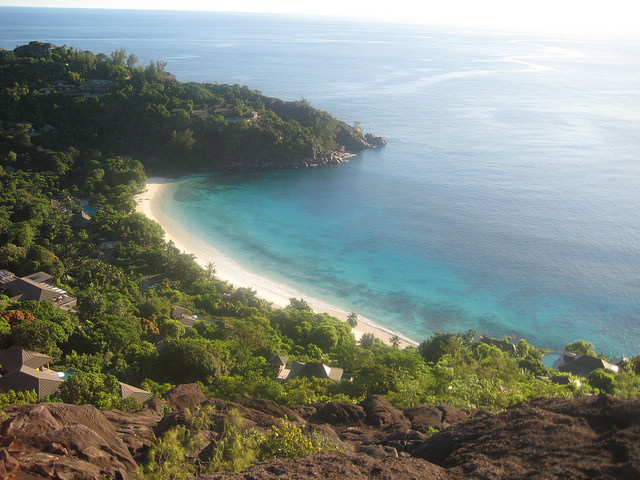 Petite Anse
Petite AnseThe top beaches on La Digue: If you visit only one beach, it has to be Anse Source d’Argent. National Geographic., CNN Travel, and US News & World Report vote Anse Source d’Argent on La Digue as the Number One Beach in the World (yes, the WORLD!), and it’s easy to see why. It was a photo of this beach that sparked my interest in the Seychelles, and the beach really is as beautiful in person as it is in photos. Anse Severe is also worth a visit.
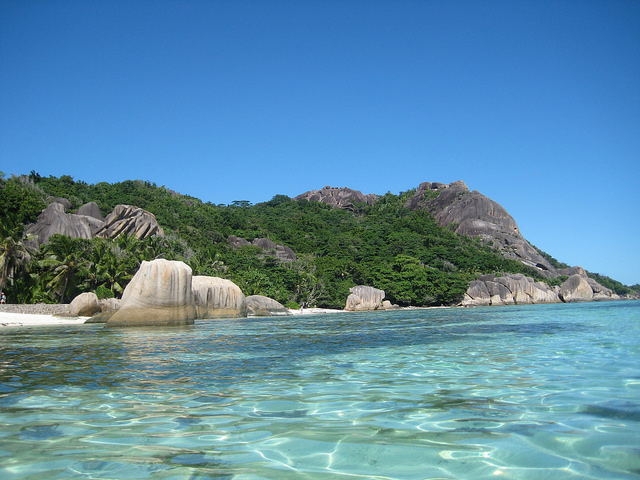 Anse Source D’Argent
Anse Source D’ArgentAll beaches are public access—there are no privately-owned beaches. If someone tells you otherwise, say you are on your way to the beach, and in theory, they can’t stop you. Most beaches, aside from the main tourist-drawn spots, are not labeled. I drove around with my trusty map and did an OK job guessing where a beach began and ended, but sometimes I wasn’t so sure. Also, most beaches do NOT have public restrooms or any sort of facilities to purchase water, sunscreen, or snacks or even rent water sports equipment, so bring everything you need.
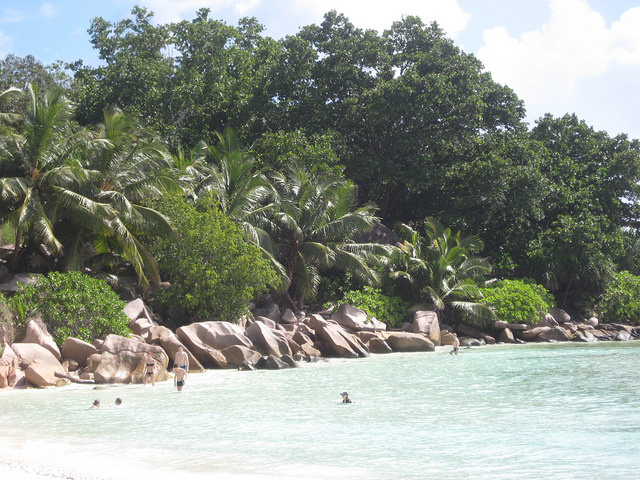 Anse Severe
Anse SevereI was traveling alone and envisioned being far out in the ocean and being able to only watch as someone ran off with my money and car keys. I found on Amazon a small, waterproof fanny pack and placed my phone, camera, credit card, car key and room key in it, sealed it, strapped it to my waist and took it swimming. Seemed like a better idea than burying these items and drawing a treasure map.
WHAT TO EAT
I mainly ate at the hotels, so I do not have restaurant reviews for you. My hotels all provide pretty amazing (and large) breakfasts that were included in the stay. Then I grabbed snacks and water for my day-long beach visits. I also dinner at the hotels, which ranged from a restaurant with full-menu options to a family-style “we are serving red snapper tonight” if you want to join us. The cuisine is typically Creole with a lot of seafood and might I add, delicious! Breakfast was typically toast, pastries, juice, coffee, meats and cheeses, eggs or pancakes (these are really what we call crepes) and tons of fresh fruit, and dinner was a typical Creole-inspired fare: seafood, rice, and veggies.
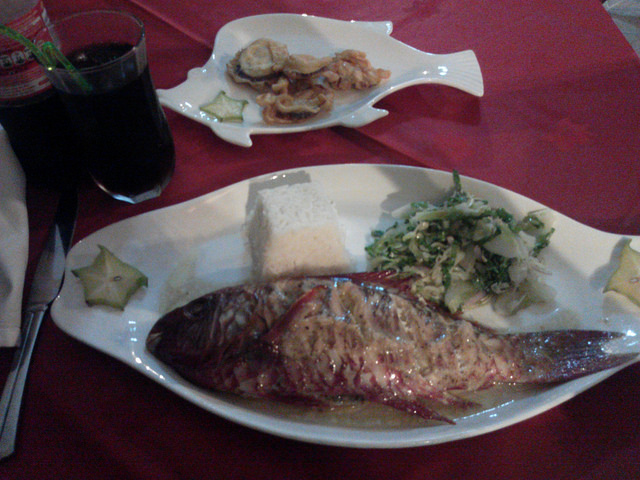
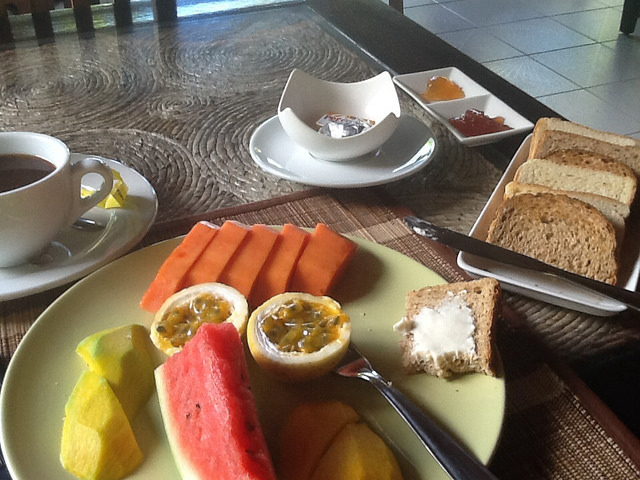
CLIMATE
I asked my cab driver, “So, what are the seasons here?” He laughed and said, “There are no seasons. There’s just the dry and rainy season.” April, May, October and November are the best months to visit because they are generally dry. True to paradise, it is always warm, and good news: almost all the islands lie outside the cyclone belt. The weather is hottest from December to April, and the humidity is very high.
LANGUAGE
Creole, English, and French are the three official languages spoken here, and many Seychellois also speak fluent Italian or German. Fun fact: the Seychelles is the only nation in the world where Creole is an official written language and not just a spoken dialect.
RELIGION
Roman Catholicism dominates in Seychelles, which was evident by every business being closed on GoodFriday, and also the entire surrounding weekend just for good measure. So if you traveling during a Catholic holiday, not much will be open.
CURRENCY
Seychellois Rupee (Rs) is their local currency (about 12Rs to $1 USD), and is accepted at local establishments (markets, taxis, ferry ports, gas (petrol) stations). Note that hotels and other establishments that cater to tourists generally only accept Euros. If you have US dollars, be prepared to be ripped off—my cab driver charged me “a good deal” of $50 (yes $50) for a 7 minute, 6 mile cab ride. Take the extra 15 minutes to stand in line at the airport currency exchange and get your US dollars exchanged into Rupees, and also do this before you leave—the Dubai airport would not exchange my Rupees for Euros or US Dollars because they did not have them in stock and had never heard of them (really?).
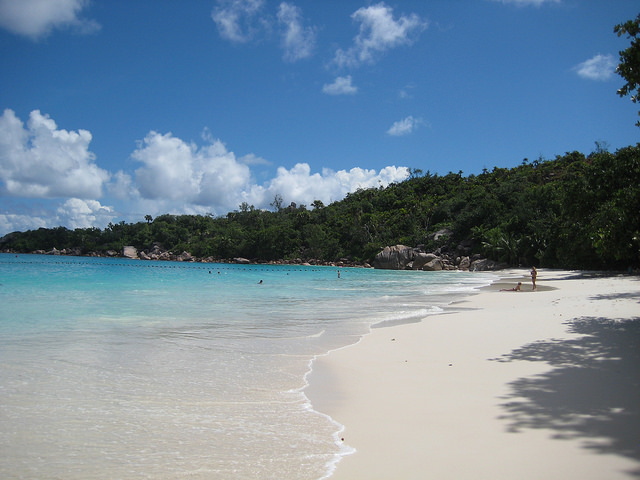 Anse Lazio
Anse LazioOTHER IMPORTANT DETAILS
The voltage on the islands is 220-240V. Seychelles uses the British standard square three-pin, 13 amp sharp electric plug, so bring an outlet adapter and also a voltage converter if your appliance does not accept 220-240 volts (most small appliances such as curling irons, hair dryers, and cell phones and your iPad are compatible with this voltage, and you do not need a converter).
They use the metric system here. Dinner is served at 18:00 (or 6:00 pm) and the speed limit is 30km/h (or 18.64 mph, which on those windy, hilly roads feels like 50 mph). I set my phone clock to metric a couple months before I left so I could get used to telling the time. Don’t even ask me what I weigh in kilos.
Wi-fi (free) was available at each of my hotels. You could buy a cheap-o cell phone and pay-as-you go phone plan (Cable & Wireless is the islands’ main carrier) if you really want to be yapping away while on the beach, but I chose to communicate via FaceTime and email for two weeks and forgo the phone calls and texting.
This is a tourism-driven economy—everyone is friendly and willing to sell you a service or goods. The tourist population is more than double the resident population at almost any given time. Because this seemed like a pretty poor population, and I knew tourism was the sole way most resident made a living, I tended to not barter much.
The island life mentality definitely reigns here, and if someone says you can come back tomorrow, be prepared to have them not be there tomorrow. Crime is low (each rental car company said, just leave the keys under the seat and the doors unlocked—no one will steal the car), and everyone told me there are no poisonous animals, insects or plants on the island. Welcome to paradise!
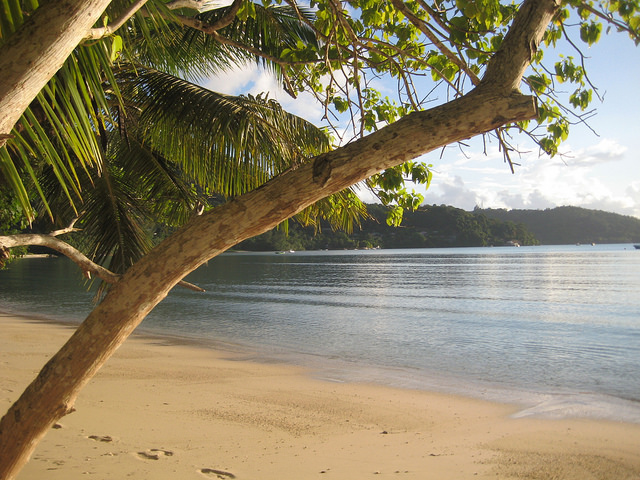 Anse La Mouche
Anse La Mouche

One day, one day! Very useful info!
- June 2, 2014